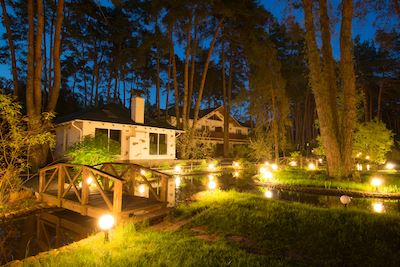Every home has outdoor lighting. But have you ever stopped to think about its purpose?
You may use a street light to highlight your driveway; it works well when you’re unloading packages after a long day. You may use a front porch light to help you enter your home. A little light makes it easier to get the key into the keyhole.
Outdoor lighting accomplishes all of this and more. When trying to decide which type of lighting is best for your home, it’s important to consider all of your options. Take into account both wet and dry locations. If you want security lights, safety and weatherproofing is a must to withstand all of the elements Atlanta’s weather can throw at it.
Security lights include:
Floodlights – they distribute a wide cone of light perfect for illuminating large spaces
Path lighting – these are ideal for creating safer walking areas
Road lighting – these have a broader lighting space and are suitable for general lighting needs
Surface-mounted lights – think of these as accent and decorative, highlighting the best features of your home
Post lighting – these lights can provide ambiance lighting throughout your landscape
Where do security lights go in your yard?
When designing your outside location, a system or plan is needed to ensure your entire area is covered. It’s important to identify any potential safety or security risks and light them accordingly. You should also take into account codes, such as restrictions on light pollution.
Assess your home. Your home changes over time. Have you added new outdoor living space? Have you put up a fence? Do you have new construction around you? All of that can impact your lighting. Pinpoint new changes to your property that have changed the lighting needs and plan accordingly.
Assess your neighborhood. Examine your landscaping and lighting needs at different times of the day, different seasons of the year. Does your neighbor’s tree impact your landscaping? Do you need additional lights to light up a path? Have codes and HOA policies changed? Always be on the lookout for dark areas and find ways to light them up.
Consider active and passive fixtures. Active lights are motion activated. Passive lights work on timers and are activated at the same time each day. Both types of technology should be worked into your landscape to offer safety and security depending on the circumstances.
Are you ready to learn more about improving your home’s outdoor lighting needs?

